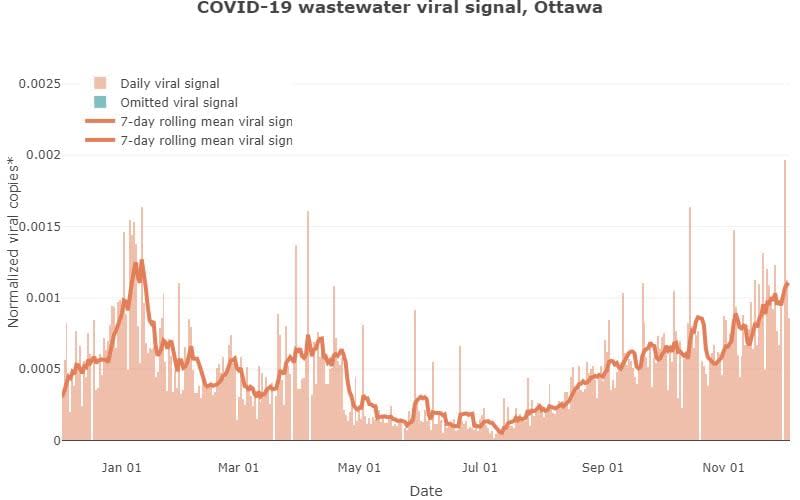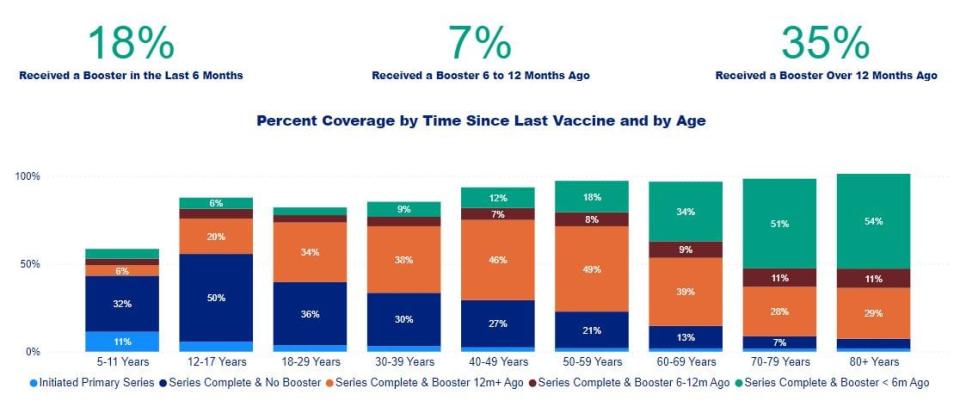Flu signals rising in Ottawa to match high COVID, RSV trends

- Oops!Something went wrong.Please try again later.
Recent developments:
Ottawa's COVID-19 numbers are rising or stable.
Individual trends are mostly very high.
Flu activity is now high, like RSV.
There are renewed calls for vaccination, particularly for people 80+.
Seventeen more COVID deaths are reported locally.
The latest
Signs point to rising influenza rates in Ottawa as experts watch for the respiratory season to peak across the province.
Flu trends have shifted from mostly low in recent Ottawa Public Health (OPH) updates to mostly high and rising.
According to the latest numbers, most COVID-19 rates remain very high and are stable or rising. Respiratory syncytial virus (RSV) activity is also high.
OPH says the city's health-care institutions remain at high risk from respiratory illnesses, as they have been since early September and are expected to remain until at least March.
Ontario's Chief Medical Officer of Health Dr. Kieran Moore said flu and COVID spread should peak in the next few weeks. Moore said the health-care system is prepared.
In a news release, children's hospital CHEO said it's "much better equipped to manage this viral season" than it was last year, citing recent health-care spending by the province.
There's less talk of a peak in Quebec.
Experts recommend people cover coughs and sneezes, wear masks, keep their hands and often-touched surfaces clean, stay home when sick and keep up to date with COVID and flu vaccines to help protect themselves and other vulnerable people.
This is a key week for immunizing against both viruses ahead of the end-of-year holidays, Moore said, as the vaccines require 10 to 14 days to take effect.
Wastewater
As of Dec. 4, the average coronavirus wastewater level was still rising to its highest point since mid-January 2023. The daily reading on Saturday was the highest of the year.
OPH considers this very high.

Researchers have measured and shared the amount of novel coronavirus in Ottawa's wastewater since June 2020. This is the data from December 2022 to Dec. 4, 2023. (613covid.ca)
Hospitals
In the past week, the average number of Ottawa residents in local hospitals for COVID-19 has fallen slightly to 71. It's been in and around the 70s for almost a month. That includes four patients in an ICU.
A separate, wider count — which includes patients who tested positive for COVID after being admitted for other reasons, were admitted for lingering COVID complications or were transferred from other health units — is stable.

Ottawa Public Health has a COVID-19 hospital count that shows all hospital patients who tested positive for COVID, including those admitted for other reasons and who live in other areas. (Ottawa Public Health)
There were 44 new patients in the previous week. OPH sees this as a high number of new hospitalizations, though fewer than last week's 54.
Tests, outbreaks, vaccines and deaths
Ottawa's weekly average test positivity rate has dropped to about 18 per cent. It has been around 20 per cent for the last month. OPH categorizes this as very high.
There are 43 active COVID outbreaks — almost all are in either retirement homes or hospitals. The total is rising and there is a very high number of new outbreaks.
The health unit reported 305 more COVID cases in the last week and four more COVID deaths: one person in their 70s, two in their 80s and one 90 or older.
According to OPH's monthly COVID vaccination update, as of Nov. 27, 18 per cent of residents over age four had a dose in the previous six months, up from nine per cent at the end of October, just as the autumn vaccine campaign was revving up.
This doesn't account for immunity from a recent infection.

Ottawa Public Health shares when residents age 5 and up last had a COVID-19 vaccine. The percentage that had one in the last 6 months doubled in the last four weeks. (Ottawa Public Health)
Nearly 100,000 doses have been administered in Ottawa over the last four weeks. The 28,400 doses given since Oct. 29 are the most in a single week since January 2022.
Ottawa's Medical Officer of Health Dr. Vera Etches told CBC Radio's Ottawa Morning this week there's room to improve the vaccination share for people 80 and over because they account for about 65 per cent of the city's COVID deaths.
Across the region
Spread and vaccination
The Kingston area's health unit says its COVID trends are stable at mostly moderate levels, flu indicators are low and RSV trends are moderate and dropping.
That area's average coronavirus wastewater reading is considered very high and dropping, while its average COVID-19 test positivity rate is a moderate, stable 14 per cent.
The Eastern Ontario Health Unit (EOHU) says it's in a high-risk time for COVID. Its wastewater readings and active outbreaks are each considered very high, with a stable 23 per cent of tests coming back positive.
Renfrew County's health unit reports a stable test positivity average around 23 per cent.
Hastings Prince Edward (HPE) Public Health says 16 per cent of its residents have had a COVID vaccine in the last six months, up from 15 per cent last week.
Hospitalizations and deaths
The EOHU has 19 COVID hospitalizations, which it also considers very high.
The Kingston area's health unit says it has 17 active COVID-19 patients in its hospitals, including anyone living in a different health unit. That is seen as moderate and stable.
Renfrew County reports seven of these patients aftre more than a year with fewer than 10.
HPE, like Ottawa, gives a weekly COVID hospital average: a stable 16, with two ICU patients.
Western Quebec has a stable 74 hospital patients who have tested positive for COVID. The province reports seven more COVID deaths there for 529 total.
HPE's COVID death toll has increased by four to 140, 34 of those this year
The health unit for Leeds, Grenville and Lanark (LGL) counties reported its 177th COVID death and the EOHU reports its 327th.
LGL data goes up to Nov. 26, when its trends were generally high and rising.

